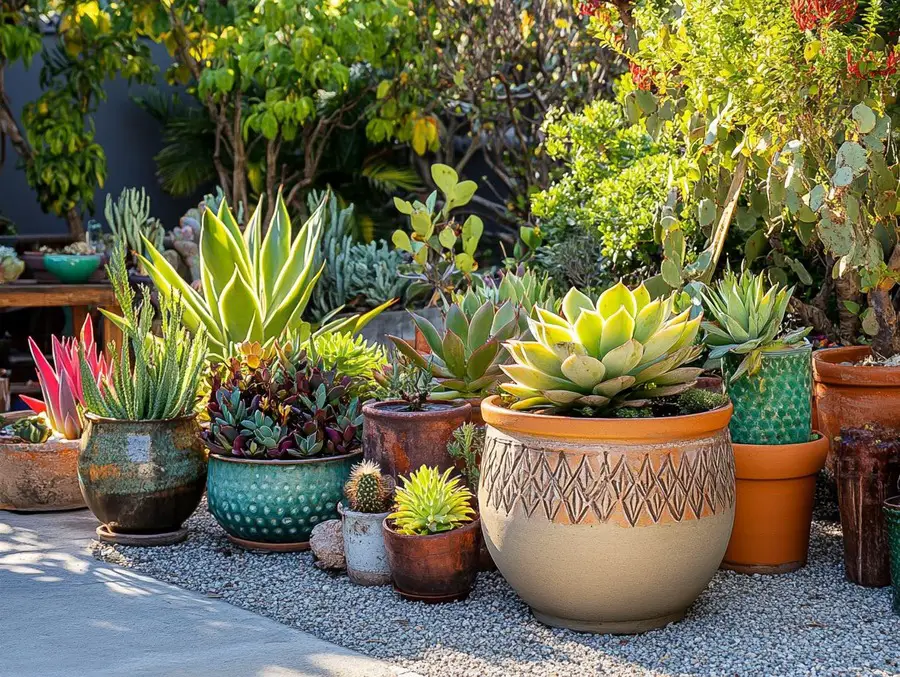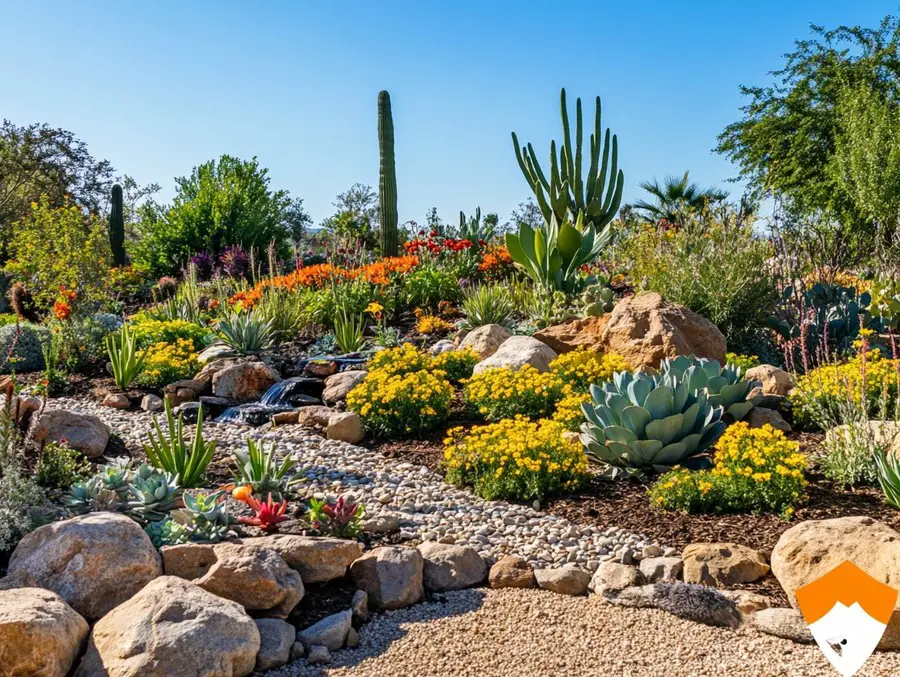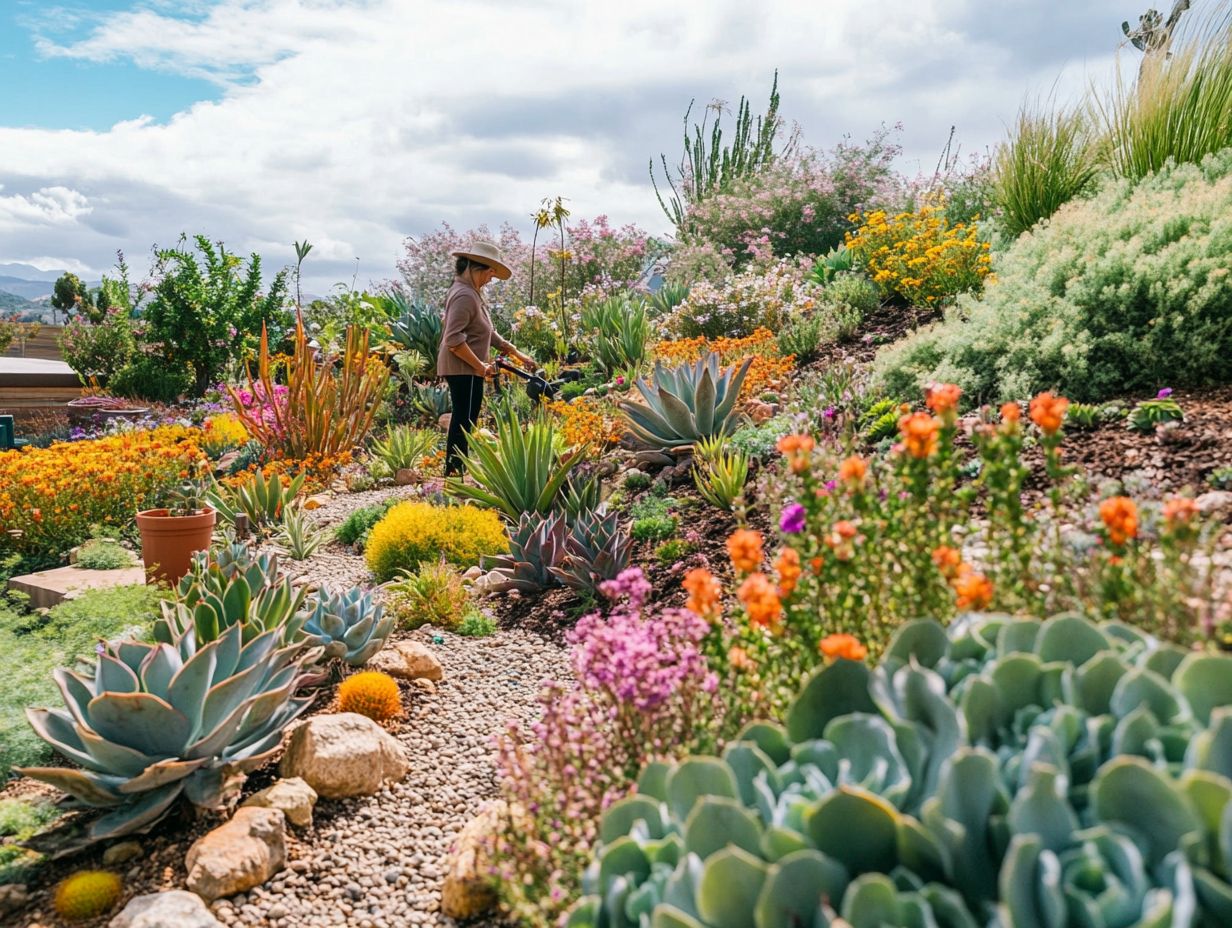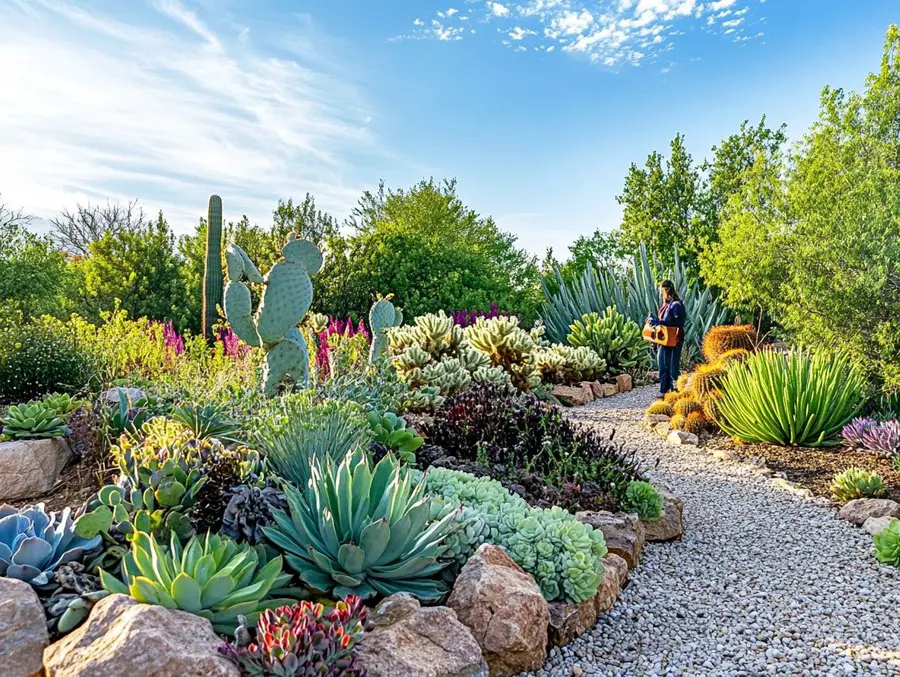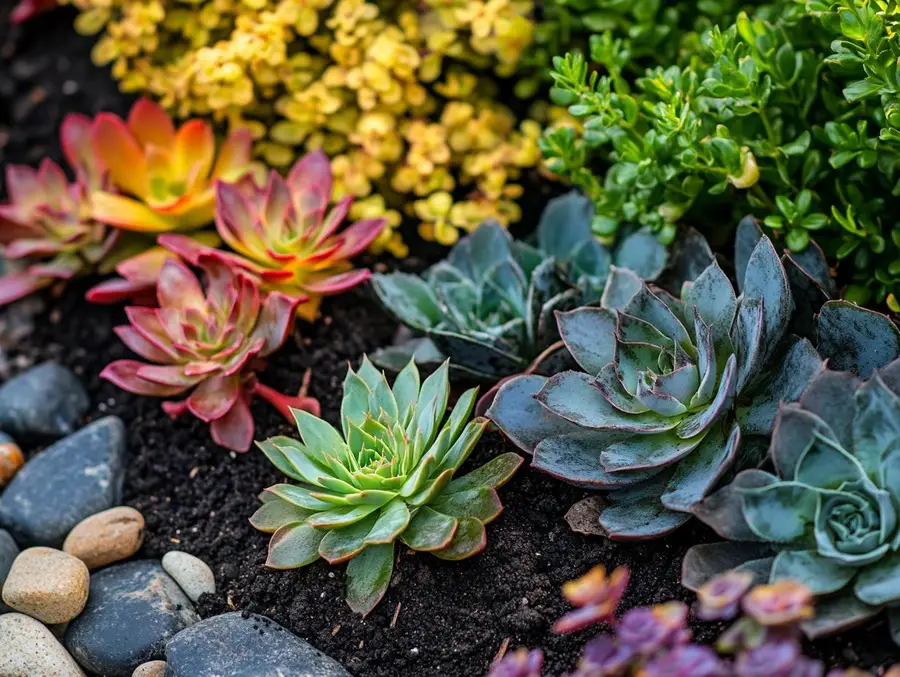We use affiliate links. If you purchase something using one of these links, we may receive compensation or commission.
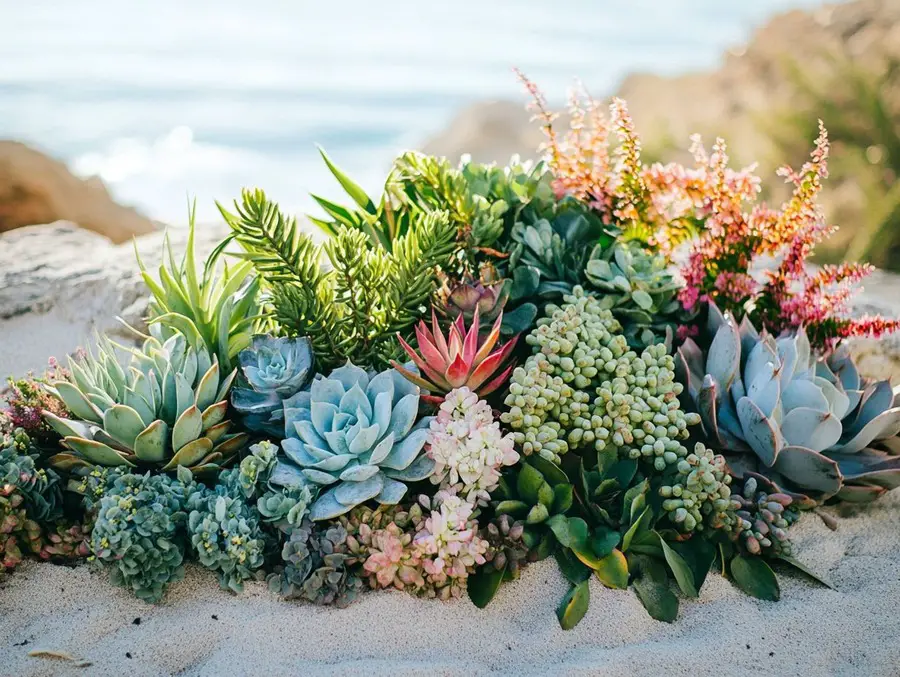
Coastal Plants for Xeriscaping offer the perfect solution for creating a low-maintenance, water-wise garden in salty, windy environments.
Struggling with dry soil, harsh coastal winds, and salt spray?
By choosing tough, drought-resistant coastal plants, you can build a thriving landscape that looks stunning while conserving water.
Learn how to design, plant, and maintain a coastal xeriscape that lasts!
Coastal Plants for Xeriscaping
Key Takeaways
- Coastal Plants for Xeriscaping are salt-tolerant, drought-resistant species that thrive in coastal conditions with minimal water.
- Popular choices include sea lavender, beach rosemary, and dune grass, which help prevent erosion while adding natural beauty.
- These plants require well-draining soil, full sun, and occasional pruning, making them ideal for sustainable, low-maintenance landscapes.
Coastal Plants for Xeriscaping: Easy-Care Plants for Beautiful Coastal Gardens
Xeriscaping is a fantastic way to create beautiful outdoor spaces while conserving water—it’s all about sustainability.
If you live in coastal areas, using native plants in your xeriscape can really pay off.
These plants are tough, able to handle harsh weather, and they don’t need as much water.
So, why not take advantage of that?
You can dive into the benefits of using coastal plants in your xeriscaping, learn how to choose the right species, and get some handy tips for designing a stunning garden.
You’ll find practical maintenance strategies that will help you achieve long-term success. You’ll be on your way to creating an eco-friendly coastal garden that thrives with minimal water!
What Are Coastal Plants for Xeriscaping?
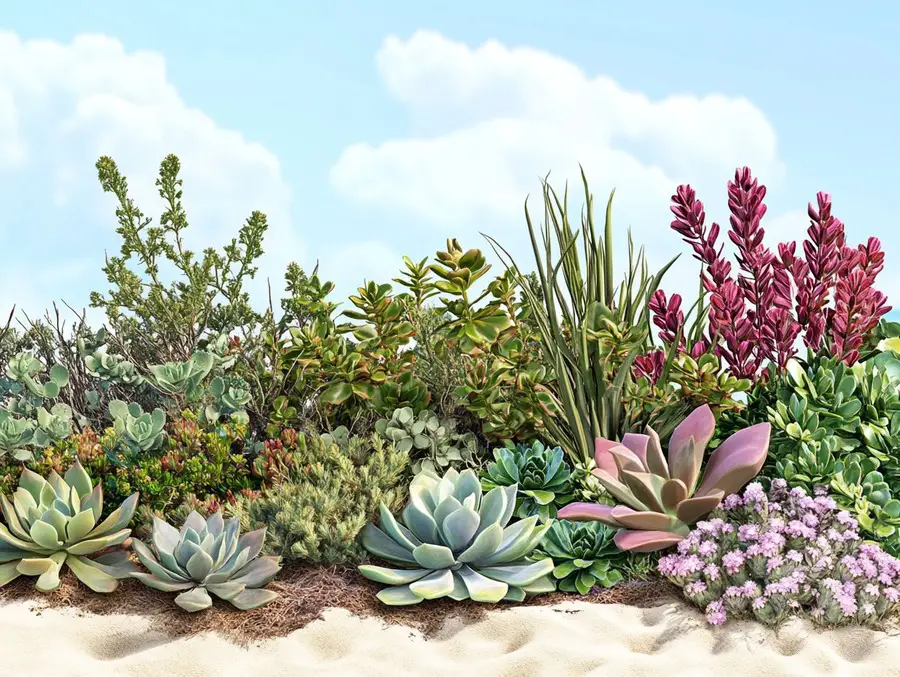
Xeriscaping is a smart landscaping approach that helps you save water by using drought-resistant plants that thrive in dry climates.
It’s a great option for eco-friendly landscaping, especially in areas with limited rainfall.
This sustainable gardening technique focuses on native plants, xerophytes, and ornamental grasses that need much less water, all while boosting biodiversity and promoting soil health with proper drainage.
By embracing the natural beauty of these plants, you can create stunning outdoor spaces without sacrificing your water conservation goals.
In terms of xeriscaping, thoughtful planning and design are key.
You’ll want to pick plants that are well-suited for your local conditions.
This conserves water, but it also cuts down on maintenance time and costs.
One effective technique is grouping plants based on their watering needs, which helps minimize waste and encourages healthier growth.
Adding mulch to your garden can also work wonders by retaining moisture in the soil and keeping those pesky weeds at bay, so your garden stays vibrant even during dry spells.
Understanding the ecological importance of using drought-resistant plants can help you create resilient landscapes that benefit the environment and provide habitats for local wildlife.
Benefits of Coastal Plants for Xeriscaping
Using coastal plants for xeriscaping brings a bunch of benefits your way, like boosting water-efficient gardening, enhancing erosion control, and promoting biodiversity in coastal ecosystems.
They really are a fantastic option for any landscaping project.
These native coastal shrubs, hardy perennials, and salt-tolerant plants are perfectly suited to thrive in tough conditions, giving you vibrant seasonal blooms and colorful foliage while also helping strengthen coastal landscapes.
By incorporating these plants into your landscape design, you’ll create a beautiful outdoor space and support important habitat restoration and ecological balance.
Adaptability to Coastal Climates
Coastal plants are pretty amazing when it comes to thriving in those tough coastal spots.
They’re like nature’s little survivors, showing off their resilience against temperature extremes, salty soil, and fierce winds, which makes them perfect for your xeriscaping plans.
These native species really know how to adapt to the climate, allowing them to flourish where other plants might struggle.
They play a big role in supporting coastal ecosystems and boosting biodiversity.
By choosing the right coastal plants for your xeriscape garden, you can create a lively, sustainable landscape that gets along beautifully with its surroundings.
These plants come equipped with some impressive adaptations.
Think thick, waxy leaves that keep water loss to a minimum, deep root systems that reach down for moisture, and the ability to handle those salty conditions close to the ocean.
Their flexible stems are another cool feature, helping them stand tall against harsh winds and salt spray, so they stay strong even when the weather gets rough.
Bringing these resilient species into your xeriscape makes your landscape look great and also helps the environment.
It provides habitats for local wildlife and cuts down on water use—something that’s super important these days with all the talk about climate change.
Low Water Requirements
One of the biggest perks of using coastal plants in xeriscaping is their low water needs, which are crucial for creating effective drought-tolerant landscapes.
These tough plants are built to thrive in dry conditions, sporting special adaptations that help them hold onto moisture and flourish, even when rainfall is scarce.
By adding drought-resistant plants to your landscape design, you create stunning visuals and cut down on your water usage, aligning perfectly with xeriscape principles that emphasize smart water use.
Coastal plants come with some unique features, like thick, fleshy leaves and extensive root systems that capture and retain moisture, helping them survive in dry environments.
These adaptations help combat the effects of drought and reduce the need for irrigation, making them a fantastic choice for eco-conscious gardeners like you.
Bringing these hardy plants into your xeriscape garden does more than just conserve water.
They also promote biodiversity by providing homes for local wildlife and add visual interest to your outdoor spaces with their vibrant colors and textures.
By embracing these plants in your landscaping efforts, you can strike a beautiful balance between aesthetics and sustainability.
Choosing the Right Coastal Plants
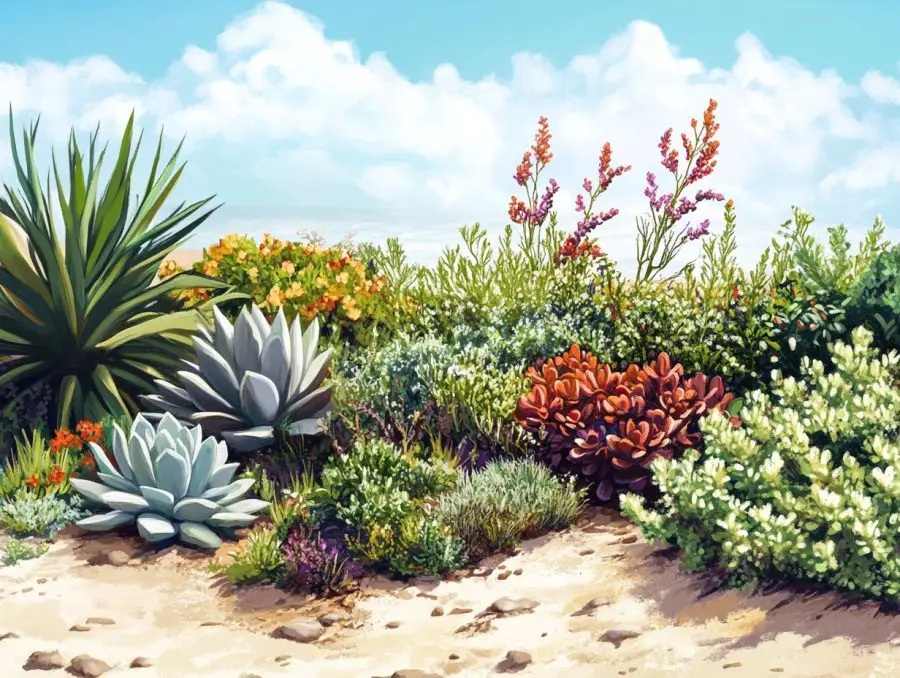
Choosing the right coastal plants is essential for creating a thriving xeriscape garden in a coastal setting.
It’s all about understanding your specific soil types, drainage conditions, and the unique traits of the local native species.
When you’re picking out plants, keep in mind things like heat tolerance, drought resistance, and how well they adapt to your local environment.
This way, your garden won’t just look stunning; it will also play a part in conserving native species and boosting coastal biodiversity.
A carefully selected mix of plants can really amp up your landscape’s visual appeal and ecological health.
Factors to Consider
When you’re picking coastal plants for your xeriscape garden, there are some important factors to keep in mind to make sure your landscape thrives and aligns with sustainable practices.
Think about things like soil health, drainage systems, and how much coastal exposure your plants will get.
These elements are key in figuring out what plants will do well, since different species have their own quirks when it comes to growth conditions, moisture needs, and handling coastal challenges like salt spray and wind.
Understanding the specific soil types in your area is essential for nailing down successful gardening techniques.
Coastal environments often have sandy or rocky soils with different pH levels, and this can really impact your plant choices and where you decide to put them.
You also need to assess the drainage capabilities; some plants love well-draining soil to avoid root rot, while others are perfectly happy in a slightly wetter environment.
And don’t forget about sunlight exposure! Coastal zones can be tricky, with some spots getting intense sunlight while others are shaded by buildings, so picking the right plants for those conditions is super important.
By weaving these elements into your planting strategy, you enhance soil health and boost the long-term success of your xeriscape garden.
Designing a Xeriscape Garden with Coastal Plants
When you’re designing a xeriscape garden with coastal plants, it’s all about strategic landscape design that balances xeriscape principles with stunning aesthetics and practical factors like irrigation and soil amendments.
By carefully selecting a mix of coastal ornamentals, hardy perennials, and vibrant succulents, you can create an eye-catching outdoor space that thrives even in dry conditions.
Don’t forget to use the right landscaping materials—mulch for moisture retention and decorative rocks for that extra visual flair.
This boosts your garden’s appeal and also supports eco-friendly practices.
Tips for a Successful Design
Creating a successful xeriscape garden design requires some careful planning and effective gardening techniques that maximize both beauty and ecological function, all while ensuring your garden looks vibrant year-round.
When you’re laying out your garden, think about group planting with native and drought-tolerant species.
This gives you a cohesive look and helps you use water more efficiently.
To keep things interesting through the seasons, choose plants that have different bloom times, foliage colors, and heights.
This way, you’ll catch the eye but also invite some exploration in your garden.
Don’t forget about regular maintenance—pruning and mulching will keep your garden healthy and thriving while making upkeep a breeze.
By thoughtfully arranging your plants and adding natural elements like rocks or gravel pathways, you can create an inviting space that connects you with nature.
Xeriscape gardening can truly be a rewarding experience!
Maintenance and Care of Coastal Xeriscape Gardens
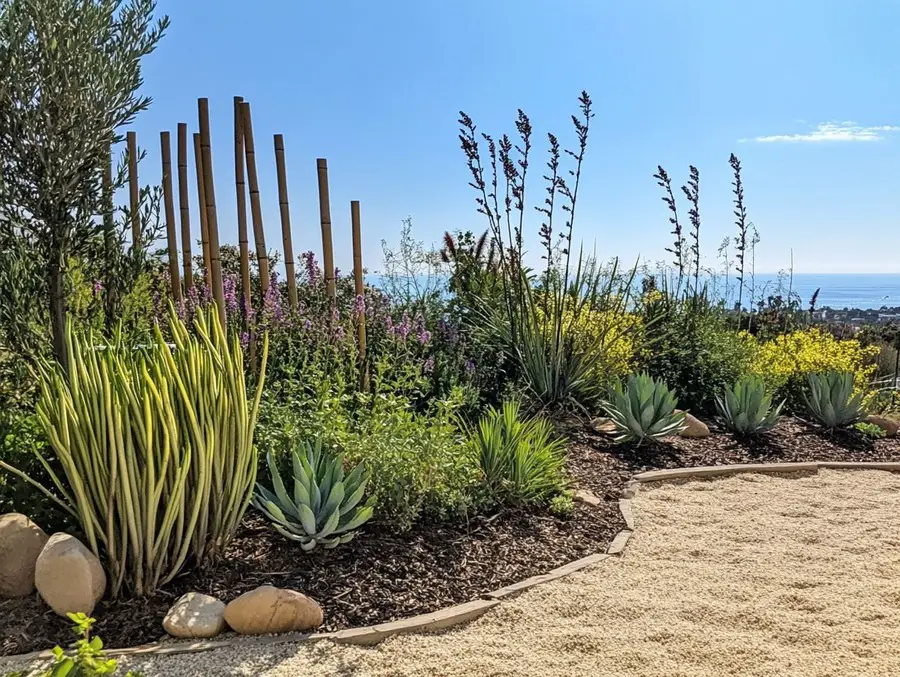
Maintaining your coastal xeriscape garden means committing to some smart strategies that will keep your low-maintenance plants healthy and thriving with minimal fuss.
Regularly checking on your irrigation systems, soil health, and the overall condition of your plants will help you catch any issues before they become problems, ensuring your garden stays vibrant and sustainable.
If you adopt organic gardening practices—like using natural mulch to retain moisture and keep those pesky weeds at bay, you’ll create a thriving ecosystem that supports coastal biodiversity while doing your part for the environment.
Practical Strategies for Long-Term Success
To ensure long-term success in your coastal xeriscape garden, it’s key for you to adopt practical gardening techniques that help your plants thrive despite seasonal changes and support moisture retention in challenging conditions.
Using eco-friendly practices like companion planting can boost your plant health and attract pollinators, creating a vibrant environment that harmonizes with nature.
Regularly checking your garden layout and the health of your plants will let you make any needed adjustments, keeping things visually interesting and ecologically balanced throughout the seasons.
By choosing drought-resistant native plants, you can cut down on water consumption and create a cozy habitat for local wildlife and biodiversity.
Don’t forget that mulching is your friend when it comes to preserving moisture.
Adjusting your watering schedule with the seasons can also help your plants grow better, even during those dry spells.
Mixing a variety of plants can foster healthy competition among species, enhancing their resilience to pests and diseases.
With a bit of careful planning and these sustainable strategies, you can cultivate a thriving coastal xeriscape garden that flourishes all year round, no matter what Mother Nature throws your way.
Frequently Asked Questions
What types of plants are suitable for xeriscaping in coastal areas?
Coastal plants for xeriscaping should be able to tolerate salty and windy conditions, as well as have low water requirements.
Some examples include succulents, ornamental grasses, and native wildflowers.
How do I prepare my soil for planting coastal plants for xeriscaping?
Before planting, it is important to amend the soil with organic matter and fertilizer to ensure proper drainage and nutrient levels.
Adding a layer of mulch can also help retain moisture.
Can I still have a lush and colorful garden with coastal plants for xeriscaping?
Yes, you can! Many coastal plants for xeriscaping offer vibrant blooms and foliage, such as sea lavender, beach rose, and lavender cotton.
You can also mix different plant textures and heights for a visually appealing garden.
Do I need to water coastal plants for xeriscaping?
While xeriscaping typically involves low water usage, newly planted coastal plants may require more frequent watering until they are established.
After that, most coastal plants can thrive with minimal watering, especially in rainy coastal areas.
How do I maintain my coastal xeriscaping garden?
To maintain your coastal xeriscaping garden, you should regularly weed and remove any dead or diseased plants. Prune as needed to encourage healthy growth, and monitor for pests or diseases.
Adding a layer of mulch can also help retain moisture and suppress weeds.
Can I attract pollinators with coastal plants for xeriscaping?
Yes, you can! Many coastal plants for xeriscaping, such as butterfly bush, yarrow, and milkweed, are attractive to pollinators like bees and butterflies.
Adding these plants can help support local pollinator populations while also adding beauty to your garden.
Best Plants for Xeriscape Gardens: Hardy & Beautiful
Xeriscape Garden Styles: Easy Low-Maintenance Options
Xeriscape Gardening Techniques: Easy Low-Water Tips
Xeriscape Garden Design & Layout: Easy Water-Wise Beauty
What is xeriscaping? A beginner’s guide to drought-tolerant landscaping – Colorado State University
Related Content
Visit my Amazon Influencer Page for videos and gardening products Grow Your Own Garden

